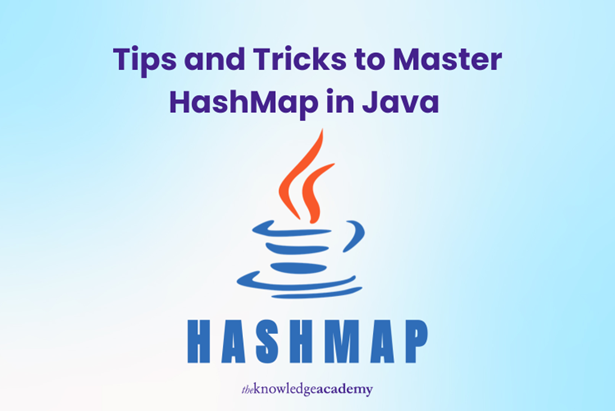Welcome to the universe of Java programming, where mastering the HashMap is just as important as earning your Java Certification. You came to the perfect place if you are looking to astonish your colleagues at the next code review or enhance your Java knowledge. Today we’ll provide some clever tips to assist you negotiate the tricky but an important domain of HashMap in Java.
Tips for Mastering HashMap in Java
There are some tips and tricks you need to know when you master HashMap in Java. Let’s see them below:
Understanding HashMap Basics
Let’s start by understanding the basics. HashMap is a data structure made for storing key-value pairs. Think of it as a dictionary where you may rapidly find information based on a custom key. It’s about retrieving data with lightning speed as much as about safely storing it. However, without a solid understanding of its mechanisms, using a HashMap can become tricky.
Choosing the Right Initial Capacity and Load Factor
Two factors primarily influence the performance of your HashMap: load factor and initial capacity. The load factor measures how full the HashMap can get before its capacity is automatically increased; the initial capacity is the count of buckets in the HashMap at the time of creation. This is like deciding how large of a suitcase you should pack for a trip—too tiny and you won’t be able to fit everything you need; too large and it will be harder to carry.
Handling Synchronisation in Multi-threaded Environments
Remember that the HashMap is not synchronised. It needs to be synchronised externally if multiple threads access it concurrently and at least one of them alters the map structurally. This can be handled by enclosing your HashMap with Collections.synchronizedMap(), thereby maintaining its safety in a multi-threaded environment without sacrificing your coding efforts.
Managing Key Collisions
Using Hash Maps properly relies largely on understanding and managing key collisions. Different keys can wind up in the same bucket in HashMap because of hashing, leading to collisions. Although HashMap manages collisions by chaining entries together, it’s important to ensure that your keys are evenly distributed to prevent performance bottlenecks.
Iterating Over HashMap
Remember that the sequence of retrieval will not always match with the sequence of insertion when you are iterating over a HashMap. This is because the HashMap prioritises speed over predictability; it does not guarantee any specific sequence of its entries. If you need a predictable order, consider using a LinkedHashMap instead.
Customising Your Hash Function
The quality of your hash function determines the efficiency of your HashMap. Good hash functions improve retrieval speed by distributing keys consistently over the buckets, subsequently lowering the possibility of collisions. Sometimes, especially in large-scale applications, customising your hash function could be required to attain the optimal performance.
Using ConcurrentHashMap for Better Concurrency
For applications that require concurrent access by multiple threads, consider using ConcurrentHashMap. It’s a robust alternative to HashMap that handles concurrent modifications more efficiently by partially locking the data structure, allowing concurrent reads and writes.
Comparing HashMap with Hashtable
While discussing HashMap, it’s also worth comparing it to its thread-safe counterpart, Hashtable. Both store key-value pairs in a hash table, but Hashtable is synchronised by default and does not allow null keys or values. Depending on your application’s requirements, choosing between HashMap and Hashtable can significantly impact performance and functionality.
Debugging Tips
Working with HashMaps can sometimes lead to unexpected behaviour, such as infinite loops or missing entries. These issues are often related to concurrent modifications or incorrect implementations of the hash function. Keep a keen eye on these areas, especially when making structural changes to the map during iteration.
Leveraging WeakHashMap for Memory Efficiency
WeakHashMap is a variant of Java’s maps that uses weak references for its keys, aiding in memory-efficient scenarios. When keys are only weakly referenced, they become eligible for garbage collection. This feature is invaluable in environments where memory conservation is critical, such as managing cache-related memory leaks, allowing automatic cleanup of outdated data.
Exploring the Richness of EnumMap
EnumMap, optimised for enum keys, maintains a natural order and offers superior performance and compactness compared to HashMap. Ideal for applications managing state machines or categorising data based on enums, EnumMap provides fast performance and orderly data handling, making it a perfect choice for specific structured data tasks.
Final Thoughts
Mastering these HashMap tips and tricks not only helps you to improve your coding abilities but also opens the path for more effective and efficient Java applications. Understanding HashMap is a huge step forward in your development path whether your goals are for a Java certification or merely to raise your programming competency.
Also Read
- ► How Do CNC Machine Shops Ensure Precision in Manufacturing?
- ► Looking for a Reliable Car Rental Solution? Why Choose Monthly Toyota Rentals?
- ► How Eng. Hossam El-Gamal Aligns
- ► UK Visa For BELIZEAN CITIZENS: Everything You Need to Know
- ► Discover Your Dream Home in Trinity by DECA
- ► How Shiinabr Conquered Fortnite: Top Tips for Beginners and Pros
- ► Automatic Driving Instructors Birmingham
- ► Avoiding Scams: A Safe Guide to Buying on Japan Car Auctions (carused.jp)
- ► All You Need to Know About Post Graduate Work Permit (PGWP) in Canada for Indian Students
- ► Tunbridge Well Taxi: Your Ultimate Guide to Tunbridge Well Airport Transfers
- ► How to Pick the Right Digital Marketing Agency for Emerging Houston Industries
- ► How AVTube is Transforming Online Media Sharing
- ► 8 Gift Hampers for Men That Will Make a Lasting Impression
- ► How Can You Pick the Ideal 9×12 Area Rug for a Home?
- ► The Ultimate Guide to Choosing the Best Laptop Bag for Women





